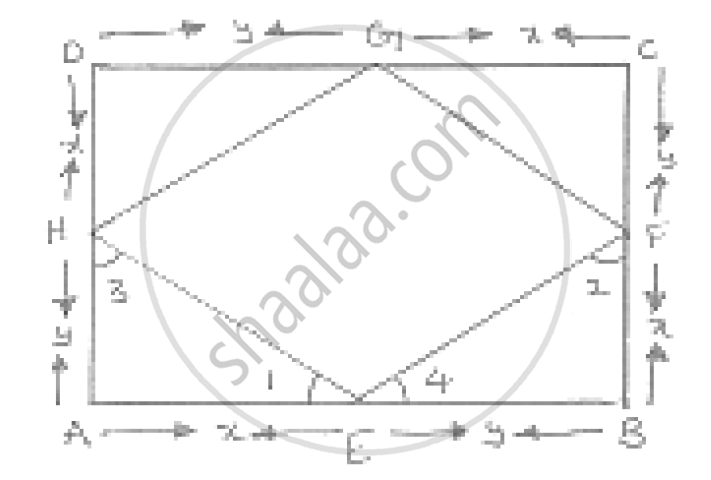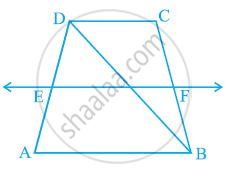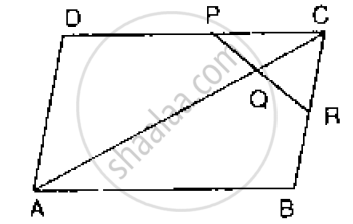Advertisements
Advertisements
प्रश्न
ABCD is a square E, F, G and H are points on AB, BC, CD and DA respectively, such that AE = BF = CG = DH. Prove that EFGH is a square.
उत्तर १

We have
AE = BF = CG = DH = x (say)
∴ BE = CF = DG = AH = y (say)
In Δ ' s AEH and BEF , we have
AE = BF
`∠`A = `∠`B
And AH = BE
So, by SAS configuration criterion, we have
ΔAEH ≅ ΔBFE
⇒ `∠`1 = `∠`2 and `∠`3 = `∠`4
But `∠`1+ `∠`3 = 90° and `∠`2 + `∠`4 = 90°
⇒ `∠`1+ `∠`3+ `∠`2 + `∠`4 = 90° + 90°
⇒ `∠`1+ `∠`4 + `∠`1+ `∠`4 = 180°
⇒ 2 (`∠`1+ `∠`4) = 180°
⇒ `∠`1+ `∠`4 = 90°
HEF = 90°
Similarly we have `∠`F = `∠`G = `∠`H = 90°
Hence, EFGH is a square
उत्तर २

We have
AE = BF = CG = DH = x (say)
∴ BE = CF = DG = AH = y (say)
In Δ ' s AEH and BEF , we have
AE = BF
`∠`A = `∠`B
And AH = BE
So, by SAS configuration criterion, we have
ΔAEH ≅ ΔBFE
⇒ `∠`1 = `∠`2 and `∠`3 = `∠`4
But `∠`1+ `∠`3 = 90° and `∠`2 + `∠`4 = 90°
⇒ `∠`1+ `∠`3+ `∠`2 + `∠`4 = 90° + 90°
⇒ `∠`1+ `∠`4 + `∠`1+ `∠`4 = 180°
⇒ 2 (`∠`1+ `∠`4) = 180°
⇒ `∠`1+ `∠`4 = 90°
HEF = 90°
Similarly we have `∠`F = `∠`G = `∠`H = 90°
Hence, EFGH is a square
APPEARS IN
संबंधित प्रश्न
ABCD is a trapezium in which AB || DC, BD is a diagonal and E is the mid-point of AD. A line is drawn through E parallel to AB intersecting BC at F (see the given figure). Show that F is the mid-point of BC.

In a ΔABC, E and F are the mid-points of AC and AB respectively. The altitude AP to BC
intersects FE at Q. Prove that AQ = QP.
In below Fig, ABCD is a parallelogram in which P is the mid-point of DC and Q is a point on AC such that CQ = `1/4` AC. If PQ produced meets BC at R, prove that R is a mid-point of BC.

Fill in the blank to make the following statement correct:
The figure formed by joining the mid-points of consecutive sides of a quadrilateral is
In triangle ABC, angle B is obtuse. D and E are mid-points of sides AB and BC respectively and F is a point on side AC such that EF is parallel to AB. Show that BEFD is a parallelogram.
In parallelogram ABCD, E is the mid-point of AB and AP is parallel to EC which meets DC at point O and BC produced at P.
Prove that:
(i) BP = 2AD
(ii) O is the mid-point of AP.
If the quadrilateral formed by joining the mid-points of the adjacent sides of quadrilateral ABCD is a rectangle,
show that the diagonals AC and BD intersect at the right angle.
In ΔABC, AB = 12 cm and AC = 9 cm. If M is the mid-point of AB and a straight line through M parallel to AC cuts BC in N, what is the length of MN?
In ΔABC, BE and CF are medians. P is a point on BE produced such that BE = EP and Q is a point on CF produced such that CF = FQ. Prove that: QAP is a straight line.
In a parallelogram ABCD, E and F are the midpoints of the sides AB and CD respectively. The line segments AF and BF meet the line segments DE and CE at points G and H respectively Prove that: ΔGEA ≅ ΔGFD
